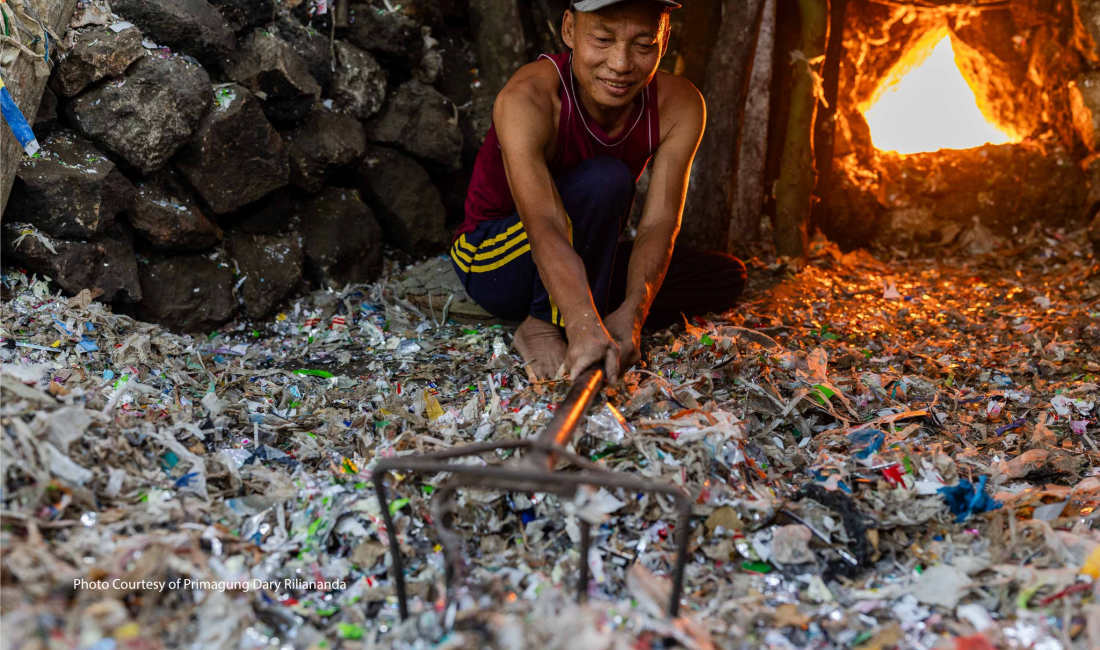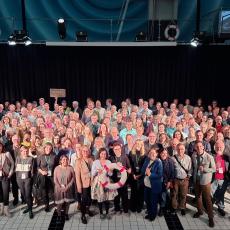East Java Villages Struggle to Manage World's Plastic Waste
This special report was produced and published by Asia Democracy Chronicles
In Gedangrowo village in Sidoarjo, a regency in the Indonesian province of East Java, piles of plastic scraps sit in the middle of residential areas. Some of the trash appears dried, with brand labels unfamiliar to Indonesians, an indication that the waste originated overseas.
The same scenery could be seen in Bangun village in Mojokerto, a city also found in East Java, where villagers seem accustomed to garbage: routinely collecting, sorting, and stuffing recyclable items into sacks. The heaps of garbage they sort end up being bought by a nearby paper mill called PT Pakerin.
In Pagak district in Malang, another city in East Java, yards once used to dry agricultural products are instead covered in chopped-up waste that they sort and sell to factories. For villagers like Sapi’i and Siyah, the work is a lifeline.
Sorting one truckload of waste can take more than a month, yielding paper to sell back to mills and plastic to peddle for RP250,000 ($15) per truckload.
“Lately the income has been uncertain because of the frequent rain,” Sapi’i said. “Sometimes we only manage three kilograms a day.”
Another resident said:
“We’ve been doing this for over 30 years. It’s normal to us because we can turn it into money.”
These individuals count among the more than 1,500 families in the district who make their living from sorting imported trash. What was once seen as degrading labor has become routine even as plastic piles grow higher than people’s homes.
But as imported waste continues to flood Indonesia, it also brings with it hidden costs: toxic smoke and microplastics that seep into the food, air, and water and endanger the villagers.
Cross-Border Pollution
Gedangrowo, Bangun, and Pagak are now among several East Java villages that have effectively become dumping grounds for imported waste, funneled through local paper factories. Many of the products are recognizable as having been sold in European Union countries like Germany and Italy, while significant amounts also come from Australia, the United Kingdom, and Japan.
The cross-border trade in waste, largely from Western countries to Asia and Africa, has been ongoing since the 1970s. In Indonesia, the import boom began in the early 2000s. U.N. Comtrade data show that the country brought in 2,900 tons of plastic waste in 2000, a figure that kept climbing until 2022, when Indonesia became the world’s third-largest plastic waste importer with more than 194,000 tons.
China’s 2018 ban on plastic waste triggered a surge in shipments to Indonesia. From 2023 to 2024, Australia sent 22,333 tons, up 27.9 percent from the year before, while Japan shipped 12,460 tons, a 14 percent increase.
The European Union has also been a major player. Eurostat recorded 8.5 million tons of EU waste exports worldwide in 2023, up 34 percent year-on-year. Indonesia took in 17 percent of its paper waste and 19 percent of its plastic waste.
By 2024, Indonesia’s Central Statistics Agency reported total imports of 262,900 tons of plastic waste worth about $105 million. The Netherlands topped the list at 107,500 tons, followed by Germany with 59,100 tons, and Belgium with 28,800 tons.
Much of this waste is used as raw material for the recycling industry, especially paper production, as local waste could not meet the current demand. But critics warn the trade reflects a bigger problem: rich countries offloading the costs of recycling by dumping their waste in developing countries like Indonesia.
Fuel for Food
In Gedangrowo, the waste sorted by Sapi’i, Siyah, Hamidah, and Saiful doesn’t stay in piles. It ends up fueling small industries like home-based tofu shops and limestone kilns.
In Tropodo, seven kilometers north, thick smoke billows from Gufron’s tofu workshop.
“At first, some tofu makers started collecting waste because it helped reduce production costs. Some even got it for free from the paper mills,” Gufron explained. “Eventually, more and more artisans followed suit. Now, most of us buy it from steamers, but even then, it’s still much cheaper than using wood or gas.”
A truckload of plastic scraps costs Rp250,000 ($15) and keeps a tofu shop running for three days. With soybean prices climbing, Gufron says:
“It’s the only way to survive.”
In Sumberrejo Village, Malang, black smoke rises from limestone kilns where Jumadi, Ridwan, and Slamet take shifts tending the furnace. Jumadi earns Rp110,000 ($6.68) a day.
Jumadi, a villager, feeds plastic into a limestone kiln that burns nonstop for three days. “I think it’s been more than ten years now,” he said. “A garbage truck from the mill drops it off every few days.” For his work, he earns Rp110,000 ($7) a day. He and two other villagers take shifts tending the furnace.
The kilns once relied on wood, but now burn dried plastic waste. “I think it’s been more than ten years now,” Jumadi said.
“Usually, a garbage truck from a paper factory drops it off every three to four days.”
The furnace must stay lit for three days and nights, sending smoke drifting across homes and roads. “We’ve all gotten used to living like this. Sometimes it even becomes a spectacle for the kids,” he said with a laugh. Satellite imagery shows more than ten active burning sites across two villages in Pagak District. With rich limestone deposits and a steady supply of plastic, lime burning has become a local mainstay.
“This is far easier and more profitable than gardening or farming,” Jumadi said. “Weather is unpredictable. Crops can fail. But you can always burn stone, rain or shine.”
Mounting Health Toll
For environmental activists, the health toll is becoming impossible to ignore. Environmental activist Aeshnina Azzahra Aqilani, known as Nina, laments that most of the villagers sort through the trash without personal protective equipment.
“If this continues, we shouldn’t be surprised if we see rising rates of serious illnesses like cancer, diabetes, and hormonal or reproductive disorders,” she said.
For instance, in Tropodo alone, another East Java village, she added that “many residents have begun suffering from respiratory infections, likely caused by inhaling smoke from burning waste used in tofu production.”
Yet many villagers insist they are unaffected. Even when someone is sick, they usually blame it on something else, not the work they do every day. Still, she refrains from faulting them, Aqilani recounted.
“They’re just trying to make a living from the waste around them. Yes, they earn money, but they’re also sacrificing their health.”
In Pagak District, smoke and ash from limestone kilns sometimes drift as far as Tlogorejo Village, four kilometers away, according to community leader Yani. “Lately, there’s been a spike in lung-related illnesses in the area. Some students from Brawijaya University and I are investigating this further,” he said.
Researchers share the concern. A 2024 study by Ecological Observation and Wetland Conservation (ECOTON) found recycled plastics in East Java containing 346 harmful chemicals, 30 of them at hazardous concentrations. Another study found microplastics – particles carried into food by smoke and wind – in every tofu sample tested in Tropodo.
Air quality in home-industry areas, including the limestone sites in Malang, has exceeded safe thresholds, says ECOTON researcher Rafika Aprilianti. For vulnerable individuals, this could trigger acute respiratory conditions.
Sidoarjo’s Head of Environment and Sanitation Services, Bahrul Aming, confirmed that his office monitored three points within 300 meters of Tropodo’s tofu chimneys where PM2.5 levels exceeded national air quality standards, posing a serious threat to public health.
Dioxins are another concern. In 2019, ECOTON and international partners found dioxin levels in eggs from Bangun and Tropodo were the second-highest in Asia, behind only Bien Hoa, Vietnam. The toxins, linked to cancer, diabetes, and hormonal disorders, were accompanied by other dangerous chemicals such as SCCPs and PBDEs, which are toxic and dangerous even at low exposure levels.
Polluting the Rivers
East Java is home to two of Java’s longest rivers: the Bengawan Solo and the Brantas.
Stretching 320 kilometers from Malang to Surabaya, the capital city of East Java, the Brantas flows through 10 regencies and four cities, sustaining more than 18.9 million people — nearly half the province’s population.
But the river is under serious threat. At least 11 paper mills sit along its banks, discharging waste into the Brantas and its tributaries. A 2023 ECOTON (Ecological Observation and Wetland Conservation) study found alarming contamination: in a 250-milliliter sample from the Porong River, researchers counted about 1,449 microplastic particles, or 15 times higher than normal.
“These particles vary in size, with some as small as plankton,” said Rafika. “That’s what makes them so dangerous, they can be easily ingested by river fish.”
The implications are alarming. When fish consume microplastics, those particles can enter the human body when the fish are eaten.
“Over time, these substances can disrupt hormonal functions, damage tissue, and impair digestion,” Rafika explained.
The danger is magnified by proximity: just four kilometers from Bangun and Gedangrowo villages lies the Kalimati Long Storage, a major water facility for Mojokerto and Sidoarjo. Even upstream, it remains vulnerable to contamination.
Strict on Paper
Indonesia has rules meant to prevent this. A joint decree by the Environment, Trade, and Industry ministries limits plastic contamination in imported paper waste to 2 percent. The Trade Ministry’s Regulation No. 31 of 2006 also requires paper waste imports to be free of toxic material, backed by permits and surveyor’s reports.
In reality, however, implementation falls apart. ECOTON found contamination levels in imported paper waste reaching 35 percent, far above the mandatory limit. Paper companies, however, have denied wrongdoing, arguing that Indonesia still falls within international recycling standards and needs imports to meet an annual shortfall of 3.2 million tons of raw paper material.
On Jan. 1, 2025, the Indonesian Ministry of Environment and Forestry announced a bold step: halting plastic scrap imports entirely. Supposedly, importers would only be allowed to bring in plastic waste with direct recommendation from this ministry, and even then, without long-term guarantees.
Despite this, industries continue to import plastic waste regularly. Import rules are split among several ministries, including Trade and Industry, leaving even the Environment Ministry unable to make binding decisions on its own.
Nevertheless, grassroots pressure is mounting. Last year, environmental activist Nina sent a formal letter to the Consulates General of Australia and Japan in Surabaya. She urged both governments to stop waste exports to Indonesia and manage their plastic wastes domestically.
Meanwhile, the World Health Organization has shifted its focus toward preventive public behavior. It has urged nations to reduce plastic usage, invest in circular economies, and expand recycling initiatives.
Ironically, Indonesia itself produces a huge volume of recyclable waste, averaging 12.87 million tons per year. But poor sorting and weak infrastructure leave much of such waste unused, locking the country into a toxic cycle of dependency on imported trash.



